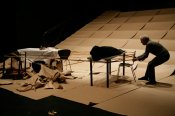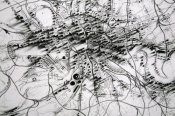16–19 October 2009
ZOO Art Fair
3–10 Shoreditch High Street, London E1
England & Co presented the work of five artists whose patterns of practice reflect obsession and persistence – repetitive methods, obsessive making, recurrent actions and images
STUART BRISLEY




Stuart Brisley, renowned as the ‘godfather’ of British performance art, gained notoriety in the 1960s and ’70s for his disturbing physical performances. At the centre of his diverse practice lies his exploration of the essential qualities of what it means to be human. He has challenged the human body in physical, psychological and emotional ways, and in his performance work engages the audience and establishes a dialogue of action and reaction that induces a release from conventions of social behaviour. Brisley is represented here by a series of photo-sequences relating to performance works from the late 1960s and ’70s; along with screenings of the new film of his 2009 performance in Lausanne and the 1973 film Arbeit Macht Frei, a gruelling performance that constructs a complex political and social metaphor about freedom. This is an opportunity for Brisley’s influence on a new generation to be made evident and to demonstrate his continuous practice and relevance. A new installation of Stuart Brisley’s Bloody House, along with recent drawings and photographs of performances from the 1970s, can be seen at England & Co gallery from 3–27 October >. Artist’s page >
CHRIS KENNY




Chris Kenny’s precarious constructions of map pieces or murmuring text – three-dimensional collages with absurdist and poetic juxtapositions of found shapes and phrases – while minimalist in appearance, in fact have links with Dada antecedents. In 1,329 Children, an abstract tour de force of tenacity, Kenny mounts a huge collection of minute faces from anonymous group photographs on pins of different lengths – images of forgotten lives are imbued with the poignancy that comes from allying the negligible with the hugely significant. He works with obsessive craft, saying that he chooses difficulty and does ‘more than is necessary’: it is obsession without the madness. Artist’s page >
GEORGIA RUSSELL




Georgia Russell takes iconic Surrealist publications and uses a scalpel to transform them by relentless dissection into almost tribal, fetishistic objects relating to André Breton’s Cabinet of Curiosities. The pages are obscured by a coating of black paint with only the covers surviving as a tracery web that contains the title and spine of the original book. The fetish she creates mirrors the obliterated content. Her photographic portraits are cut away with rhythmic, obsessive cutting to create vestigial likenesses. Artist’s page >
HARALD SMYKLA




Harald Smykla is represented by a series of Movie Protocol drawings and will also perform live Movie Protocol notations on the England & Co stand. The usually passive process of watching a movie becomes an active one. It is another means of exploring time and process, core concerns of his work.Smykla’s Movie Protocols are pictographic shorthand notations of films, created in real time as he watches them. Sequences of swift line drawings chase one another like words written on a page, while he attempts to make some graphic record of every single take. This near-impossible task is his attempt to capture film through live drawing, and it generates its own visual language: hectic cuts and on-screen movement result in rapid, near-indefinable graphic ciphers, whereas when the camera lingers, Smykla can generate some pictorial detail, even recognizable portraits of actors. The use of low-tech overhead projection enables him to make a Movie Protocol a public performance, which creates a simultaneous parallel screening of a very immediate personal and physical interpretation of the film. As the performance lasts exactly as long as the film, signs of exhaustion, stress, despair and relief can be detected both in the artist and in the drawings.
Artist’s page >
JASON WALLIS-JOHNSON




Jason Wallis-Johnson uses relentless process and extreme patience. He makes mesmerising, fine drawings by hand to produce what seem to be mechanically-made abstract designs and devices on paper. He painstakingly draws extremely thin lines, one after the other, by hand, using the pressure of a pin through carbon-paper to make his marks, using self-imposed mathematical ‘rules’ to decide the frequency and distance between each applied line. His three-dimensional silicone map works, like his light-box maps, reflect both this persistent process and his literal obsession with maps: microscopic cities are made with reference to maps and population statistics. Artist’s page >
